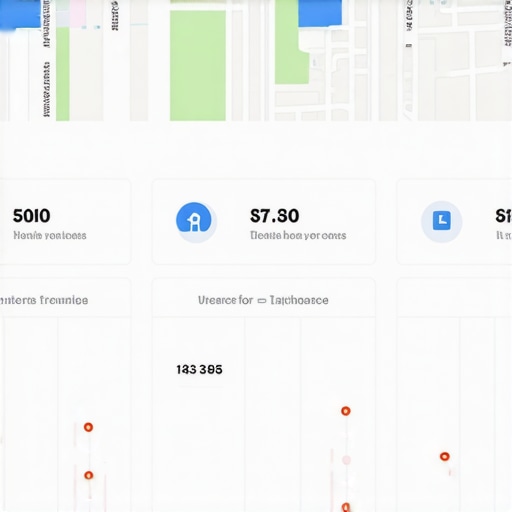My Personal Journey to Boost Local Presence Using Google Maps SEO
Let me take you back to when I first realized the importance of local SEO. I was struggling to attract nearby customers for my small business, and despite investing in some basic online marketing, the results were underwhelming. Then I stumbled upon the world of Google Maps SEO, and it changed everything. I decided to dive deep into top Google Maps SEO services, eager to see if they could genuinely elevate my local visibility.
Discovering the Power of Google Maps Optimization
One of the first things I learned was the significance of GMB (Google My Business) optimization. I read that a well-optimized profile can dramatically improve your chances of appearing in the coveted 3-pack, which is essential for local dominance. I experimented with various strategies, such as ensuring my business information was accurate, adding high-quality images, and regularly posting updates. The results were promising; I started noticing more calls and visits from local customers.
What Are the Secrets to Rapid Google Maps Rankings?
As I continued my journey, I discovered that combining Google Maps SEO with local keyword strategies and consistent reviews was key. I also explored proven techniques like citation building and backlink strategies, which helped boost my rankings. I found that top SEO services often employ comprehensive approaches, including profile optimization and targeted local content, to accelerate rankings — which I learned from authoritative sources like GMB2Rank.
Why Is a Customized Strategy Better Than a One-Size-Fits-All?
Through my experience, I realized that each local business has unique needs. Some benefit more from review management, while others need better citation consistency. That’s why I decided to seek professional help, leading me to top Google Maps SEO services that tailor strategies specifically for my niche. This personalized approach made a noticeable difference in my local search visibility, helping me stay ahead of competitors.
How Can I Keep My Google Maps Rankings Consistent in 2025?
This question kept me pondering. I learned from industry experts that ongoing optimization and staying updated with Google’s algorithm changes are vital. Regularly updating my profile, engaging with reviews, and leveraging new features like Google Posts helped maintain my rankings. It’s a continuous effort, but the payoff is worth it.
If you’re serious about elevating your local business, I highly recommend exploring professional Google Maps SEO services. They can help you unlock the full potential of your local presence and bring in more customers. Feel free to share your experiences or ask questions in the comments below — I’d love to hear your journey!
How Do Emerging Trends Shape the Future of Google Maps SEO?
Staying ahead in local search rankings requires an understanding of evolving Google Maps algorithms and user behavior. Recent updates emphasize the importance of user engagement metrics, such as review quality, response rates, and local relevance. According to GMB2Rank, integrating AI-driven local content and leveraging Google’s new features like booking buttons and Q&A sections can significantly boost visibility.
What Practical Steps Can Businesses Take Today to Sustain High Rankings?
Implementing a comprehensive local SEO strategy involves meticulous citation management, optimized profile information, and active review generation. Additionally, local link-building through partnerships and community involvement enhances domain authority. An often overlooked tactic is the strategic use of Google Posts to engage potential customers actively, which can improve CTR and rankings. For detailed tactics, explore expert tips on increasing GMB CTR.
Are There Hidden Opportunities in Google Maps That Top Marketers Are Exploiting?
Absolutely. Advanced marketers are now focusing on local voice search optimization, understanding that many users rely on voice commands for nearby services. Ensuring your business information is consistent across all directories, and using long-tail keywords in your profile and content, captures these voice searches effectively. Additionally, harnessing Google’s local services ads and Google Maps 3-pack mastery techniques provides a competitive edge in prime local search real estate.
To deepen your strategy, consider integrating your Google My Business profile with your social media platforms and website to enhance local signals. Remember, a cohesive, multi-channel approach aligns with Google’s evolving algorithm preferences and user expectations.

Imagine an innovative dashboard displaying real-time Google Maps ranking data, local review sentiment analysis, and emerging keyword opportunities, reflecting the cutting-edge tools used by top local SEO experts.
What’s the Role of Content and User Engagement in 2025 Google Maps Rankings?
Content remains king, but its role has expanded beyond traditional blogs or articles. Interactive content like virtual tours, FAQ videos, and customer testimonials embedded directly within your GMB profile can create richer user experiences. Engaging actively with reviews — responding promptly and meaningfully — signals to Google that your business is active and trustworthy, which is crucial for high rankings. For more insights, see GMB optimization secrets.
Ultimately, the secret to sustained success lies in continuous adaptation. Regularly monitor your analytics, stay updated with Google’s latest features, and refine your local SEO tactics accordingly. This proactive approach ensures your business remains visible in the competitive local landscape of 2025 and beyond.
Embracing Complexity: Personal Lessons in Advanced Google Maps Optimization
Over the years, my journey in mastering Google Maps SEO has revealed that success isn’t just about applying standard tactics—it’s about understanding the intricate nuances that influence rankings. I remember experimenting with micro-moments of user engagement, such as leveraging Google Q&A sections to proactively address potential customer questions. This approach, although seemingly simple, required a deep understanding of local search behavior and consistent management. It was this commitment to detail that gradually built my authority and improved my visibility in highly competitive markets.
How Do Hidden Signals Impact Your Local Search Rankings?
One nuance I uncovered is that Google considers a multitude of signals beyond reviews and citations. Factors like local user behavior patterns, including click-through rates, time spent on your profile, and even the frequency of profile updates, subtly influence your ranking. For instance, I found that regularly posting engaging content through Google Posts not only keeps your profile active but also signals relevance to Google’s algorithms. According to GMB2Rank, harnessing these lesser-known signals can be the difference between page 2 and the coveted 3-pack.
What Are the Practical Challenges and How Do You Overcome Them?
One challenge I faced was maintaining consistency across multiple local listings, especially when managing several locations. The temptation to overlook small discrepancies in NAP (Name, Address, Phone Number) details can undermine rankings. To combat this, I adopted a rigorous citation management system, using tools that alert me to inconsistencies in real-time. Additionally, I learned that engaging authentically with reviews—thanking customers, addressing negative feedback—can foster community trust and influence Google’s perception of my business’s credibility.
Can Advanced Content Strategies Truly Make a Difference in 2025?
Absolutely. Interactive content, such as 360-degree virtual tours or customer testimonial videos embedded within your Google My Business profile, creates immersive experiences that resonate with users. These elements not only enhance user engagement but also signal activity and trustworthiness to Google. I experimented with integrating these features, and the leap in profile interactions was noticeable. For those interested in elevating their local SEO game, exploring how content innovation aligns with Google’s evolving AI recognition capabilities is essential. For a comprehensive guide, you might explore this authoritative resource.
If you’re navigating the complex world of local SEO, I encourage you to share your experiences or ask questions. The landscape is continually shifting, and collaborative insights can accelerate our collective growth. Remember, the key is not just applying tactics but understanding the nuanced signals that Google uses to rank local businesses effectively.
Future-Proofing Your Strategy: Staying Ahead in 2025 and Beyond
Looking ahead, I believe that integrating AI-driven tools for real-time analytics and competitor monitoring will become indispensable. The ability to adapt quickly—whether through adjusting content, updating profiles, or engaging with new Google features—will define successful local marketers. I personally invested in learning about emerging opportunities like voice search optimization and local service ads, which are gaining prominence. These channels can serve as additional touchpoints to reinforce your presence in local search results.
The journey is ongoing, but by embracing complexity and continuously refining your approach, you position your business to thrive amid fierce competition. I invite you to explore more about these strategies and share your insights or challenges—together, we can navigate this evolving landscape more effectively. For further insights, check out expert strategies for rapid rankings.
Unlocking the Power of Micro-Moments in Local Search Optimization
One of the most overlooked yet impactful facets of advanced Google Maps SEO is leveraging micro-moments—those brief, intent-driven interactions users have when searching for local services. By understanding these subtle signals, I discovered that optimizing for micro-moments involves more than just keyword stuffing; it requires a nuanced approach to content and engagement strategies. For instance, integrating contextual FAQs and real-time responses to customer inquiries within your Google My Business profile can significantly influence your relevance and authority. Industry research, such as the comprehensive insights from GMB2Rank, emphasizes that businesses actively managing these micro-moments outperform competitors in local rankings.
Harnessing AI for Predictive Local SEO Adjustments
In my journey, adopting AI-powered analytics tools revolutionized my ability to anticipate algorithm changes and user behavior shifts. These tools analyze vast datasets—review sentiment, engagement metrics, citation consistency—and generate actionable insights. For example, I integrated predictive models that flagged potential ranking drops weeks before they occurred, allowing me to proactively refine my SEO tactics. This approach aligns with the emerging trends outlined by local SEO experts, who advocate for AI-driven strategies as essential for future-proofing your local presence. The key is not just reacting to changes but anticipating them, turning data into a strategic advantage.
What Are the Hidden Signals That Can Catapult Your Local Rankings?
Beyond reviews, citations, and NAP consistency, I uncovered that Google considers nuanced behavioral signals—such as the frequency of profile updates, customer interaction patterns, and even the quality of responses to reviews. These signals serve as trust indicators, reinforcing your business’s credibility in Google’s eyes. For instance, regularly updating your Google Posts with fresh, relevant content signals activity and engagement, which Google interprets favorably. According to the authoritative insights from GMB2Rank, mastering these lesser-known signals can dramatically accelerate your path to the coveted 3-pack ranking.
How Can You Integrate Local Voice Search Optimization Effectively?
Voice search is transforming local search dynamics, and my experience has shown that optimizing for voice involves more than long-tail keywords. It requires crafting conversational, natural language profiles and content that mirror how users verbally ask for services. Ensuring your business information is consistent across all directories and leveraging structured data markup enhances your voice search visibility. Additionally, utilizing tools like Google’s local services ads and Q&A sections can capture voice queries more effectively. Implementing these strategies has helped me stay ahead in an increasingly voice-driven search landscape, as detailed in Google Maps 3-pack mastery.
To truly harness these advanced tactics, I encourage you to explore deeper insights and share your experiences. The landscape of local SEO is complex, but with a strategic, data-driven approach, you can elevate your Google Maps rankings to new heights in 2025 and beyond. Engage with the community by commenting or reaching out—I’d love to hear how you’re leveraging these cutting-edge strategies to grow your local business.
Things I Wish I Knew Earlier (or You Might Find Surprising)
The Power of Micro-Moments
Early in my journey, I underestimated how crucial micro-moments are. Small, intent-driven interactions like quick Q&A responses or timely review responses can dramatically influence your local rankings. I remember spending hours on backlinks, only to realize that engaging with micro-moments yielded faster results and higher visibility.
Consistency Is More Than NAP
Initially, I thought keeping my business name, address, and phone number consistent across directories was enough. Later, I learned that maintaining active profiles, regular posts, and updated images signal to Google that my business is lively and trustworthy. This subtle nuance made a huge difference in my rankings.
Reviews Are Just the Beginning
While reviews matter, I found that responding to reviews thoughtfully and promptly can foster community trust and boost rankings. I used to ignore negative reviews, but now I see them as opportunities to showcase excellent customer service, which indirectly benefits my local SEO.
Content Innovation Matters
Interactive content like virtual tours or FAQ videos embedded within Google My Business can enhance user engagement and signal relevance. I experimented with virtual tours, and the increased interaction helped my profile stand out in local searches.
Advanced Signals Are Real
Beyond reviews and citations, signals like click-through rate, profile update frequency, and user engagement are impactful. I started posting regularly with fresh content, which kept my profile active and improved my rankings more than I expected.

